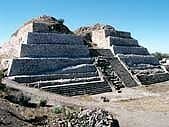To describe the magically eclectic high desert town of San Miguel de Allende, think in colors. As the morning sun peeks over the Sierra Madre, the 470-year-old town begins to glow: the towering spires of La Parroquia church in the center of town blaze fairytale pink; houses along the winding cobbled streets shimmer saffron, tomato red, ochre, butternut, mango; massive jacaranda trees fill the skyline with shocks of purple; canopies of bougainvillea drip fuchsia down the alleyways; a blue doored bakery floods the street with aromas of freshly baked bread; multitudes of long necked egrets explode out of trees like white shooting stars; street vendors sell mixed cups of color—pink watermelon, orange papaya, yellow pineapple, all mixed with sprinkles of green lime. Hallucinatory murals of animals and humans splash buildings; walls graced with vibrantly painted frescoes—fantastical visions of Mayan poems and wild creations—bleed color all over the street.
And this is just early morning.
Set in the mountainous reaches of the Mexican desert, this astounding city of colonial architecture, thermal hot springs, perpetual blossoms and perfect light has an everlasting spring. Recently declared a UNIESCO World Heritage Site, San Miguel de Allende, contains a lively mix of Mexicans and foreigners. Ten percent of its 80,000 residents are expats from the U.S., Canada, Europe and elsewhere, people who’ve left their old lives behind to immerse themselves year-round in San Miguel’s myriad cultural offerings, climate, and dynamic artistic community.
This city that once lured Diego and Frida, the muralists Orozco and Siqueiros, portrait photographers and Beats continues to entice artists, writers and musicians from the world over. In San Miguel you’ll find not only Mexico’s colorful holidays and fiestas—there are at least 50 “official” fiestas in town every year—you’ll also find art shows, concerts, lectures, films, plays, jazz, ballet, yoga, and meditation. You’ll find lessons in photography, water color, music therapy and belly dance. You’ll also hear music in the streets every day, mariachis playing melodies for all occasions—wallowing in the sorrow of lost love, or spirited tunes to set you dancing salsa or a polka in the street.
San Miguel’s jardin, the center of the city since 1737, is the most popular spot in town. In this shady town square, people drink coffee on benches beneath lollipop-shaped laurel trees as they gaze up at the spires of La Parroquia spiking the blue sky; vendors sell ice cream, balloons, tortillas, and corn-on-the-cob laced with mayo, chili and lime; young people parade the perimeter looking for love. To sit in the jardin on a sunny day or cool evening is to step back into a pre-television era when every small town had a square where people met to gossip, greet, laugh and watch the world go by.
Like the jardin and the city’s two famous art institutes, San Miguel’s library—the Biblioteca—is another place to meet friends. In its palm-shaded patios you’ll see Mexicans and expats taking turns tutoring each other in English and Spanish. This unique library—half of it is outside—boasts one of Mexico’s largest English-language selection of books, and just about every day of the year you can attend an interesting talk or lecture, slide show, reading or concert. The odds are even good you’ll find copies of your favorite magazines here which you can read while sipping a cappuccino in the garden patio.
There’s a reason why people talk about falling for San Miguel, returning here year after year like visiting an old love. It was Jean-Paul Sartre who once wrote, “I never stop creating myself.” The door is open in San Miguel for you to do just that. All you have to do is walk through the door.
Laurie Gough is author of Kite Strings of the Southern Cross: A Woman’s Travel Odyssey and Kiss the Sunset Pig (www.lauriegough.com).
You can meet Laurie at the conference this year, or even work with her in the Travel Writing Workshop she’s teaching!





